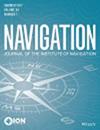High-Precision Vision Localization System for Autonomous Guided Vehicles in Dusty Industrial Environments
IF 2
3区 地球科学
Q1 ENGINEERING, AEROSPACE
引用次数: 0
Abstract
Autonomous guided vehicles (AGVs) are widely used in ports and warehouses during the ongoing Fourth Industrial Revolution (Industry 4.0). AGVs can transfer cargoes to their correct destinations or carry industrial robots to work from various directions. In cases like Arthur et al. (2008) and Hofacker (1993), engineers put a robot on an AGV to finish aircraft manufacturing instead of a fixed robotic system such as a gantry crane or guide rail on the ground. An AGV can avoid structural transformation and has high adaptability in various applications. However, highly accurate AGV localization is required for safe driving and precise robotic operations. Several studies have investigated high-precision localization methods for AGVs since 1908. A classical method involves setting magnetic or electric cables underground for tracking. AGVs would follow the cable path by electromagnetic induction (Chen et al., 2004) using special sensors. This method is still widely used in modern factories. It can maintain a position accuracy of around 10 mm. However, it damages the original ground and can be easily affected by magnetic and electric fields. Some studies used a monocular camera (Wu et al., 2019) to track colored stripes and quick response (QR) codes. The positioning error in those studies could be State Key Laboratory of Tribology, Tsinghua University, Beijing, China多尘工业环境下自动导向车辆的高精度视觉定位系统
在正在进行的第四次工业革命(工业4.0)期间,自动导引车(agv)广泛应用于港口和仓库。agv可以将货物转移到正确的目的地,或者携带工业机器人从各个方向工作。在像Arthur et al.(2008)和Hofacker(1993)这样的案例中,工程师将机器人放在AGV上完成飞机制造,而不是固定的机器人系统,如地面上的龙门吊或导轨。AGV避免了结构改造,对各种应用具有很高的适应性。然而,为了安全驾驶和精确的机器人操作,需要高度精确的AGV定位。自1908年以来,一些研究对agv的高精度定位方法进行了研究。一种经典的方法是在地下设置磁性或电力电缆进行跟踪。agv将使用特殊传感器通过电磁感应沿着电缆路径移动(Chen et al., 2004)。这种方法在现代工厂中仍被广泛使用。它可以保持约10毫米的位置精度。然而,它破坏了原有的地面,并且容易受到磁场和电场的影响。一些研究使用单目摄像机(Wu et al., 2019)来跟踪彩色条纹和快速反应(QR)代码。这些研究中的定位误差可能是清华大学摩擦学国家重点实验室,中国北京
本文章由计算机程序翻译,如有差异,请以英文原文为准。
求助全文
约1分钟内获得全文
求助全文
来源期刊

Navigation-Journal of the Institute of Navigation
ENGINEERING, AEROSPACE-REMOTE SENSING
CiteScore
5.60
自引率
13.60%
发文量
31
期刊介绍:
NAVIGATION is a quarterly journal published by The Institute of Navigation. The journal publishes original, peer-reviewed articles on all areas related to the science, engineering and art of Positioning, Navigation and Timing (PNT) covering land (including indoor use), sea, air and space applications. PNT technologies of interest encompass navigation satellite systems (both global and regional), inertial navigation, electro-optical systems including LiDAR and imaging sensors, and radio-frequency ranging and timing systems, including those using signals of opportunity from communication systems and other non-traditional PNT sources. Articles about PNT algorithms and methods, such as for error characterization and mitigation, integrity analysis, PNT signal processing and multi-sensor integration, are welcome. The journal also accepts articles on non-traditional applications of PNT systems, including remote sensing of the Earth’s surface or atmosphere, as well as selected historical and survey articles.
 求助内容:
求助内容: 应助结果提醒方式:
应助结果提醒方式:


